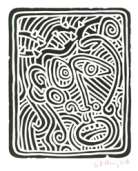
Stones 1

Stones 1
Signed Print
Keith Haring
Price data unavailable
There aren't enough data points on this work for a comprehensive result. Please speak to a specialist by making an enquiry.
54 x 36cm, Edition of 60, Lithograph
Auction Results

Track auction value trend
Meaning & Analysis
This signed lithograph from 1989 is a limited edition of 60 from Keith Haring’s Stones series. Stones 1 shows Haring’s characteristic bold black lines inverted to white to create an expressive face against a frenzied background of lines and thorns.
Notable for their labyrinthine designs, the prints in Keith Haring’s Stones series are striking examples of the Pop artist’s ability to create complex images while maintaining the simplicity of line. Produced as lithographs just one year before the artist passed away from AIDS-related complications, the works in this series are reminiscent of Haring’s early subway drawings which earned him both notoriety and acclaim.
Stones 1 shows an expressive face against a frenzied background of lines and thorns in what could be perceived as an homage to the iconography of the Ecce Homo tradition in western art. Conversely, the work also represents Haring’s debt to non-western traditions, echoing the bold lines of Pre-Columbian art – especially those of Nazca lines – and aboriginal art. With this marriage of influences, the Stones series can be seen as the epitome of Haring’s hybrid style that knew no difference between high and low, ancient and modern, east and west.
Though Haring spent much of the mid to late '80s working with silk screens, this move back to lithography shows his complete mastery of print as a medium. Haring produced large editions throughout his career, but each is characterised by the careful precision and vibrancy of the one that comes before it, demonstrating his dedication to the process.